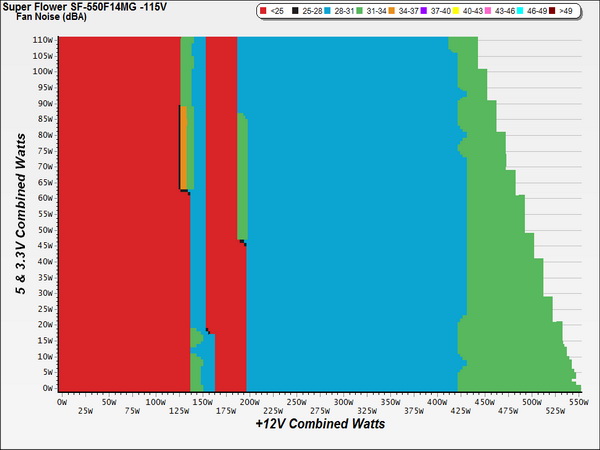Super Flower Leadex Gold 550W PSU Review
Super Flower has made quite an impact on the PSU market. Its Leadex platform enjoys huge popularity, both under SF's brand name and other companies like EVGA. The newest Leadex Gold-rated PSU with 550W capacity is on our test bench today.
Why you can trust Tom's Hardware
Efficiency, Temperature And Noise
Efficiency
Our efficiency testing procedure is detailed here.
Using the results from the previous page, we plotted a chart showing the SF-550F14MG's efficiency at low loads, and loads from 10 to 110 percent of the PSU's maximum-rated capacity.
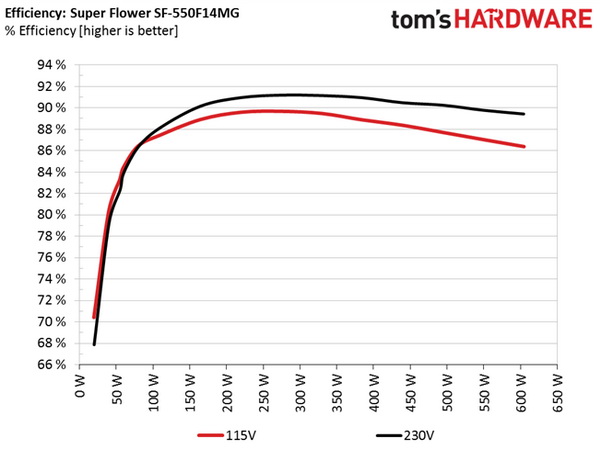
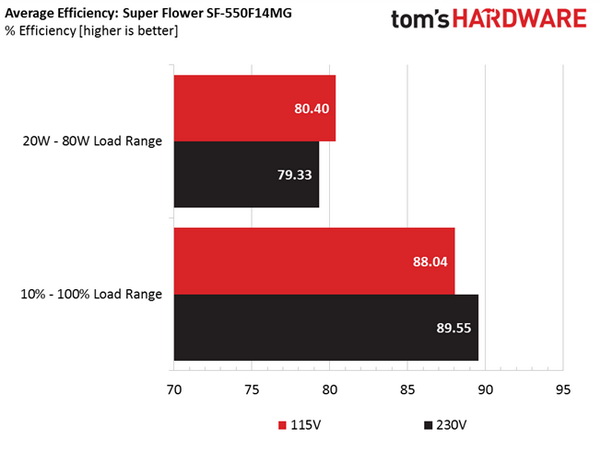

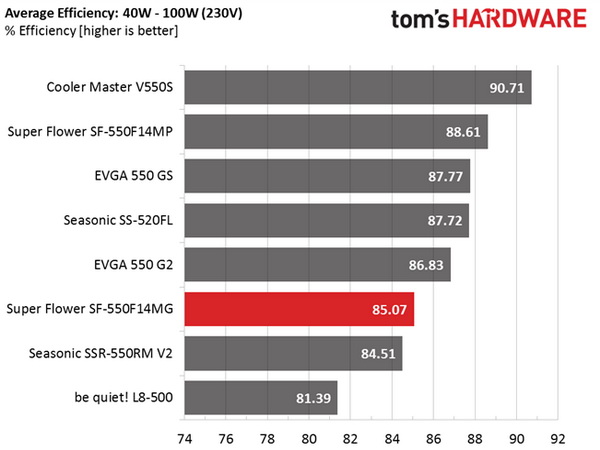
Under normal loads, the SF-550F14MG lands in the middle of the pack, behind EVGA's 550 G2. It doesn't do so well under light loads either, landing a ways under the 550 G2.
Efficiency At Low Loads
In the following tests, we measure the efficiency of the SF-550F14MG at loads significantly lower than 10 percent of the device's maximum capacity (the lowest load the 80 PLUS standard measures). The loads we dialed were 20, 40, 60 and 80W. This is important for representing when a PC is idle, with power-saving features turned on.
| Test # | 12V | 5V | 3.3V | 5VSB | DC/AC (Watts) | Efficiency | Fan Speed (RPM) | Fan Noise | PF/AC Volts |
|---|---|---|---|---|---|---|---|---|---|
| 1 | 1.184A | 0.491A | 0.479A | 0.195A | 19.63 | 70.43% | 0 | 0 dB(A) | 0.823 |
| 12.313V | 5.029V | 3.318V | 5.110V | 27.87 | 115.0V | ||||
| 2 | 2.393A | 0.989A | 0.994A | 0.390A | 39.73 | 80.31% | 0 | 0 dB(A) | 0.906 |
| 12.313V | 5.028V | 3.318V | 5.100V | 49.47 | 115.0V | ||||
| 3 | 3.607A | 1.485A | 1.505A | 5.091A | 59.84 | 84.44% | 0 | 0 dB(A) | 0.948 |
| 12.313V | 5.026V | 3.316V | 5.091V | 70.87 | 115.1V | ||||
| 4 | 4.808A | 1.990A | 1.990A | 0.785A | 79.79 | 86.44% | 0 | 0 dB(A) | 0.952 |
| 12.313V | 5.025V | 3.316V | 5.080V | 92.31 | 115.0V |
We expected better efficiency under light loads, especially in the 20W test. As you can see, the fan didn't engage at all throughout these tests, yielding silent operation.
5VSB Efficiency
The ATX specification states that 5VSB standby efficiency should be as high as possible, recommending 50 percent or more with 100mA of load, 60 percent or higher with 250mA of load and 70 percent or higher with 1A or more of load.
We take four measurements: one each at 100, 250 and 1000mA, and one with the full load the 5VSB rail can handle.
Get Tom's Hardware's best news and in-depth reviews, straight to your inbox.
| Test # | 5VSB | DC/AC (Watts) | Efficiency | PF/AC Volts |
|---|---|---|---|---|
| 1 | 0.102A | 0.52 | 71.23% | 0.111 |
| 5.116V | 0.73 | 115.1V | ||
| 2 | 0.252A | 1.29 | 76.79% | 0.211 |
| 5.109V | 1.68 | 115.1V | ||
| 3 | 1.002A | 5.10 | 78.95% | 0.373 |
| 5.085V | 6.46 | 307.5V | ||
| 4 | 3.002A | 14.97 | 77.13% | 0.462 |
| 4.986V | 19.41 | 115.1V |
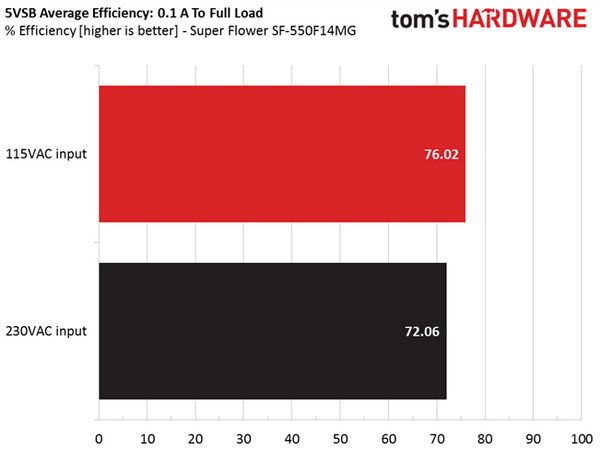

Since Super Flower uses the same 5VSB circuit as the 550 G2, the efficiency results are similar. Unfortunately, that means the 5VSB rail isn't very efficient. Ideally, we should see one or two readings with over 80 percent efficiency.
Power Consumption In Idle And Standby
| Mode | 12V | 5V | 3.3V | 5VSB | Watts | PF/AC Volts |
|---|---|---|---|---|---|---|
| Idle | 12.335V | 5.032V | 3.319V | 5.118V | 8.22 | 0.584 |
| 115.1V | ||||||
| Standby | 0.10 | 0.017 | ||||
| 115.1V |
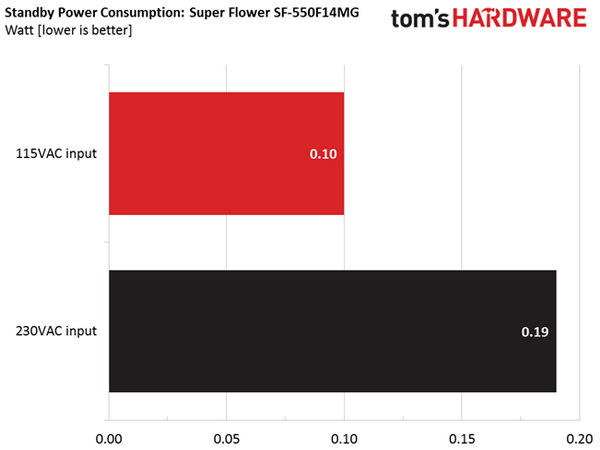
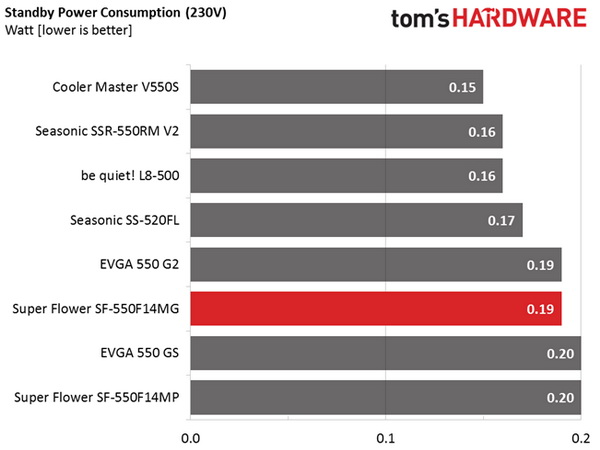
The table above shows the power consumption and voltage values of all rails (except -12V) when the PSU is idle (powered on, but without any load on its rails), and the power consumption when the PSU is in standby mode (without any load, at 5VSB).
Vampire power is low in both cases, allowing for higher efficiency readings on the 5VSB rail, given that its design allows for it, of course.
Fan RPM, Delta Temperature And Output Noise
Our mixed noise testing is described in detail here.
The first chart below illustrates the cooling fan's speed (in RPM), and the delta between input and output temperature. The results are obtained at 38 °C (100.4 °F) to 47 °C (116.6 °F) ambient temperature.
The next chart shows the cooling fan's speed (RPM) and output noise. We measure acoustics from one meter away, inside a small, custom-made anechoic chamber with internals completely covered in sound-proofing material (be quiet! Noise Absorber kit). Background noise inside the chamber was below 18 dB(A) during testing, and the results were obtained with the PSU operating at 38 °C (100.4 °F) to 47 °C (116.6 °F) ambient temperature.

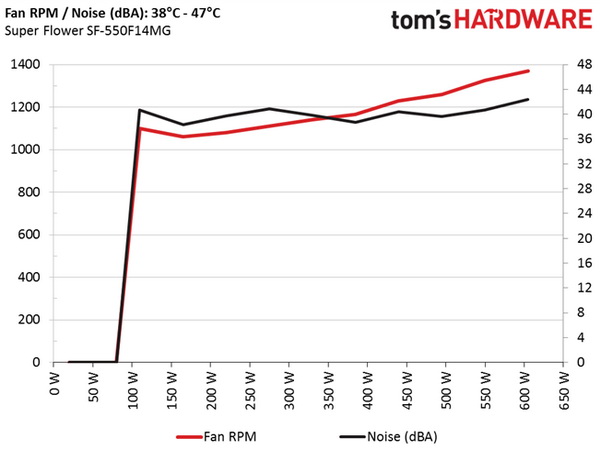
The following graph illustrates the fan's output noise over the entire operating range of the PSU. The same conditions of the above graph apply to our measurements, though the ambient temperature was between at 28 °C (82.4 °F) to 30 °C (86 °F).
Under normal temperature operating conditions and with the semi-passive mode enabled, the PSU is quiet enough. The passive operation doesn't last for long. However, even when the fan is engaged it spins slowly. Hence, its noise output is low; in most cases it will pass unnoticed. Even when the fan spins at full speed, with 28 °C to 30 °C ambient temperatures, the noise doesn't exceed 34 dB(A).
Current page: Efficiency, Temperature And Noise
Prev Page Load Regulation, Hold-Up Time And Inrush Current Next Page Cross-Load Tests And Infrared Images
Aris Mpitziopoulos is a contributing editor at Tom's Hardware, covering PSUs.
-
blazorthon Granted the EPS and PCIe wires don't see very high current in most situations (especially the EPS with Haswell or Skylake CPUs), I hardly ever see other PSUs using thinner gauge wires, so I can't imagine it saving enough money to be worth going thinner than the recommended 18 gauge wires most other PSUs have regardless of capacity.Reply -
Quaddro Why crapxon?Reply
I'm tired to see bulged crapxon..
If this one use jap caps, it'll be absolutely perfect.. -
mctylr ReplyUnfortunately, the bridge rectifier's markings are on its hidden side, and we try to avoid desoldering these type of parts since they are extra sensitive to increased heat
Huh? Since when are bridge rectifiers particularly heat sensitive? I would say that bridge rectifiers are not worth the hassle to desolder, unless you suspect it was an underrated part.
APFC controller is an NCP1653A provided by ON Semiconductor. It's installed on a small vertical PCB and is covered by insulation tape in order to decrease EMI noise.
That looks like paper and vinyl / PVC electrical tape wrapped around the vertical PCB, which provides electrical isolation only, I doubt it would make measurable difference in EMI. -
Aris_Mp According to my experience so far they are, unfortunately.Reply
This provides some EMI protection. There is no need for electrical insulation on this board. As for the degree or EMI protection I can examine this with my EMC probes (once I find the time to do it). -
Andi lim this review said uses a half-bridge topology, I only see one main capacitor. half bridge usualy uses 2 main cap and 2 main switcher right ?Reply -
Aris_Mp the number of APFC caps has nothing to do with the primary topology. However yes half-bridge uses 2 switchers.Reply -
Andi lim You are right, this is half bridge with LLC series resonant converter, nothing wrong with the primary capacitor.Reply
